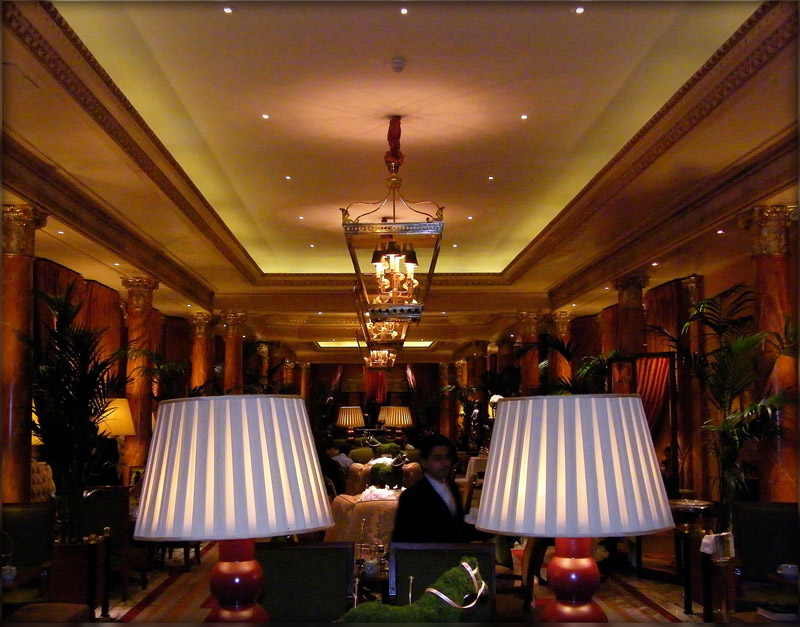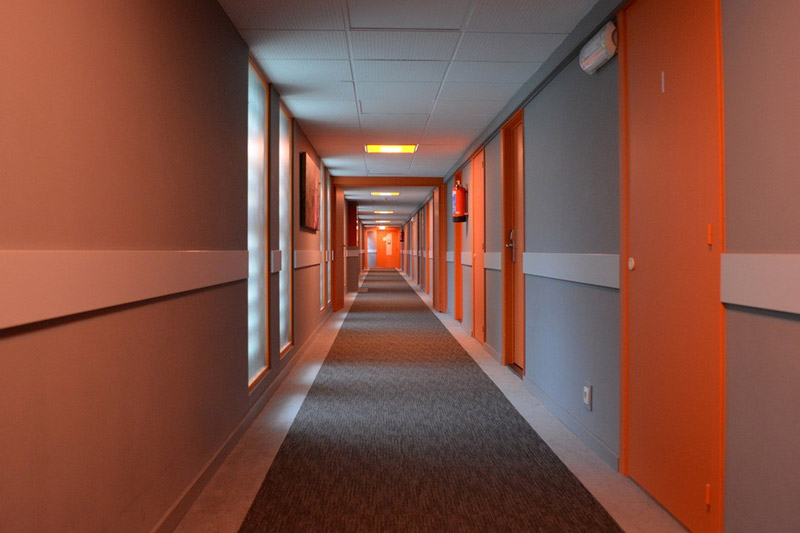25 Tips and Tricks For Hotel Lighting

Here are our best tips and tricks for creating perfect lighting within hotels:
- Use warm, inviting lighting in common areas to create a welcoming atmosphere. To implement this tip, use lighting fixtures that emit warm colors, such as yellow or orange. Choose fixtures that create a soft glow, rather than harsh, bright light. Place fixtures strategically throughout common areas, such as lobbies and lounges, to create a warm, inviting atmosphere.
- Make sure lighting fixtures are proportionate to the size of the room. When selecting lighting fixtures, consider the size of the room they will be used in. Choose fixtures that are proportional to the space, avoiding fixtures that are too large or too small. This will ensure that the lighting is balanced and visually pleasing.
- Use dimmer switches to adjust lighting levels based on the time of day and activities happening in the space. Dimmer switches allow you to adjust the brightness of the lighting in a room. This is especially useful in areas where different activities take place, such as dining areas or conference rooms. By adjusting the lighting levels, you can create different moods and atmospheres throughout the day.
- Use directional lighting to highlight artwork or architectural features. Directional lighting is a great way to draw attention to specific features in a room. Use spotlights or track lighting to highlight artwork, sculptures, or architectural features, such as columns or archways. This will create visual interest and add depth to the space.
- Install motion sensors to turn lights on and off in common areas to save energy. Motion sensors can be used in common areas, such as hallways and stairwells, to turn lights on and off automatically. This is a great way to save energy, as the lights will only be on when someone is present in the area.
- Use color-changing LED lights to create different moods and atmospheres. Color-changing LED lights can be used to create different moods and atmospheres in a room. For example, blue lighting can create a calm, relaxing atmosphere, while red lighting can create a sense of excitement and energy. Use these lights strategically throughout the space to create different effects.
- Use lighting to create focal points in the room, such as highlighting the bed or a piece of furniture. Lighting can be used to create focal points in a room, drawing attention to specific areas or pieces of furniture. Use pendant lighting or spotlights to highlight the bed in a guest room, or a unique piece of furniture in a lobby or lounge.
- Use pendant lighting to create visual interest and add depth to the space. Pendant lighting is a great way to add visual interest to a room. Use pendant lights in dining areas, lobbies, or other common areas to create a sense of height and drama. Choose fixtures that complement the overall design aesthetic of the space.
- Use under-cabinet lighting in bathrooms to create a relaxing spa-like atmosphere. Under-cabinet lighting can be used in bathrooms to create a relaxing spa-like atmosphere. Choose warm, inviting lighting fixtures that emit soft light. Install these fixtures underneath cabinets or vanities to create a soft glow that will help guests feel relaxed and rejuvenated.
- Install task lighting in work areas, such as desks or bedside tables, to provide ample illumination for reading and other activities. Task lighting is important in work areas, such as desks or bedside tables. Install fixtures that provide ample illumination for reading or other activities. Choose fixtures that can be adjusted to different angles, so that the light can be directed where it is needed.
- Install wall sconces to create a warm, inviting glow. Wall sconces are a great way to create a warm, inviting glow in a room. Choose fixtures that emit warm colors, such as yellow or orange, and that can be adjusted to different brightness levels. Install sconces strategically throughout the space, such as on either side of a bed or above a fireplace, to create a cozy, intimate atmosphere.
- Use recessed lighting to create a clean, modern look. Recessed lighting is a great way to create a clean, modern look in a room. Choose fixtures that blend seamlessly into the ceiling, providing a subtle source of illumination that doesn't detract from the overall design aesthetic of the space. Use these fixtures in hallways, conference rooms, or other areas where a clean, modern look is desired.
- Use natural light whenever possible to create a bright, inviting atmosphere. Natural light is a great way to create a bright, inviting atmosphere in a room. Whenever possible, use windows and skylights to bring in natural light. Choose window treatments that allow light to filter in, such as sheer curtains or blinds. This will create a welcoming atmosphere that guests will love.
- Use chandeliers to add a touch of elegance to the space. Chandeliers are a classic lighting fixture that can add a touch of elegance to any space. Use them in dining areas, lobbies, or other areas where a formal, sophisticated look is desired. Choose fixtures that complement the overall design aesthetic of the space, and that are proportionate to the size of the room.
- Use floor lamps to create a cozy, intimate atmosphere. Floor lamps are a great way to create a cozy, intimate atmosphere in a room. Choose fixtures that emit warm, inviting light, and that can be adjusted to different brightness levels. Place them strategically throughout the space, such as next to a sofa or armchair, to create a comfortable, inviting atmosphere.
- Use decorative lighting fixtures to add personality and flair to the space. Decorative lighting fixtures, such as pendant lights or chandeliers with unique designs, can add personality and flair to a room. Choose fixtures that complement the overall design aesthetic of the space, and that make a statement. These fixtures can be used in lobbies, dining areas, or other common areas where guests will appreciate their unique style.
- Use backlit mirrors in bathrooms to create a stylish, functional design element. Backlit mirrors are a stylish and functional design element that can be used in bathrooms. These mirrors provide ample illumination for grooming and other activities, while also adding a touch of style to the space. Choose mirrors that complement the overall design aesthetic of the bathroom, and that provide ample illumination without being too harsh.
- Use LED strip lighting to create a subtle, modern look. LED strip lighting is a great way to create a subtle, modern look in a room. Use these lights underneath cabinets, along baseboards, or in other areas where a subtle source of illumination is desired. Choose lights that emit cool, white light for a clean, modern look.
- Use table lamps to create a warm, inviting atmosphere in guest rooms. Table lamps are a great way to create a warm, inviting atmosphere in guest rooms. Choose fixtures that emit warm, inviting light, and that can be adjusted to different brightness levels. Place them on bedside tables, desks, or other surfaces to create a comfortable, inviting atmosphere.
- Use uplighting to accentuate architectural features and create shadows on walls and ceilings. Place fixtures at the base of walls or columns to create a dramatic effect.
- Use shadow play to create a dramatic effect. Install fixtures that create shadows on walls or ceilings, adding depth and interest to the space.
- Use outdoor projection mapping to create a visually stunning effect. This technique can be used to project images or videos onto walls or other surfaces, creating a dynamic, immersive experience.
- Install custom lighting fixtures that are unique to the hotel. These fixtures can be designed to complement the overall design and style of the hotel, while adding a memorable touch to the guest experience.
- Use light sculptures or installations to create a dramatic focal point in the room. These installations can be created using a variety of materials, including glass, metal, and fabric.
- Use multiple layers of lighting to create a dynamic, immersive effect. Layer different types of lighting fixtures and effects to create a sense of depth and interest in the space.

